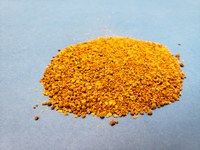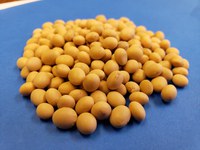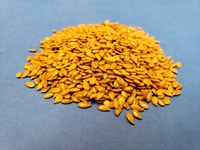Central Grasslands Forum - Spring 2020
A Walk Through the Pasture
Kevin Sedivec, Interim Director, CGREC
As I write this story I can finally say spring has arrived in North Dakota. The grass is green and growing, with temperatures above 60° F – even forecasted for 80s on May 19 and 20. We have been wet this spring (2.42 inches since April 1, or 118% of normal) and with the cool temperatures, field drying conditions have been poor.
However, our shallow loamy soils have saved us because they dry faster than the “good” soils. We harvested the last of our 2019 corn crop in April, had our cereal forage and oat variety trials seeded by May 9 and small grains seeded by May 13.
Calving season went well with great weather in March and April. Our livestock crew only had to deal with one storm. The cows and calves will be turned out to pasture May 19-21. We have started the fourth year of the patch-burn grazing study (finishing the first rotation, where a quarter of each pasture is burned each year) and the third year of the modified twice-over rest rotation study. Including the season-long control replicates, this study uses 400 cow/calf pairs, 20 bulls, and 2,395 acres of rangeland. This is the first study in the world to compare patch-burn grazing with rotational and season-long grazing that analyzes the impacts on soils, vegetation, livestock, birds, pollinators, and mammals.
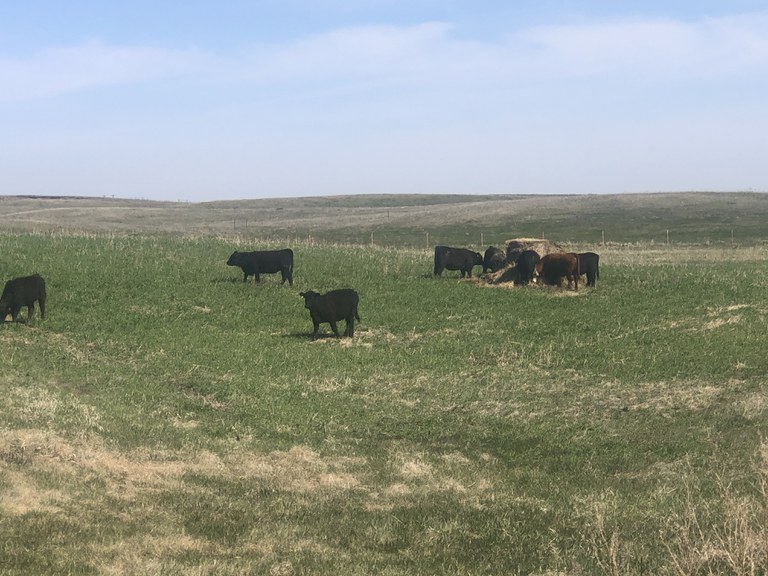
So, What’s New this Spring at the Center?
This spring we started a few new projects. These projects include:
1) Grazing select winter cereals for livestock performance, cost efficiency, and soil health. We tested spring forage production of winter rye, winter wheat, and winter triticale. We then turned out yearling heifers on May 15 to look at performance and cost to feed per day by cereal type. A note: Free-choice prairie hay for the heifers was provided because the lush growth from the winter cereals is 75-80 percent water. Cost of seed per acre was $21.25, $27.20, and $33.15 for winter rye, wheat, and triticale; respectively.
2) Assess if removal of Kentucky bluegrass litter and thatch found in the soil will enhance the expression of native grasses and forbs, and enhance the microbial populations. We will remove the litter and thatch in May on plots with a rotatory steel brush attached to a skid steer.
3) Impacts of patch-burn grazing with cow/calf pairs on buckbrush communities. We tested patch-burn grazing, patch-burn only, grazing only and no burn-no grazing treatments. Also, we also tested precision agriculture using a drone to collect imagery to assess the value of drone imagery with traditional vegetative data collection.
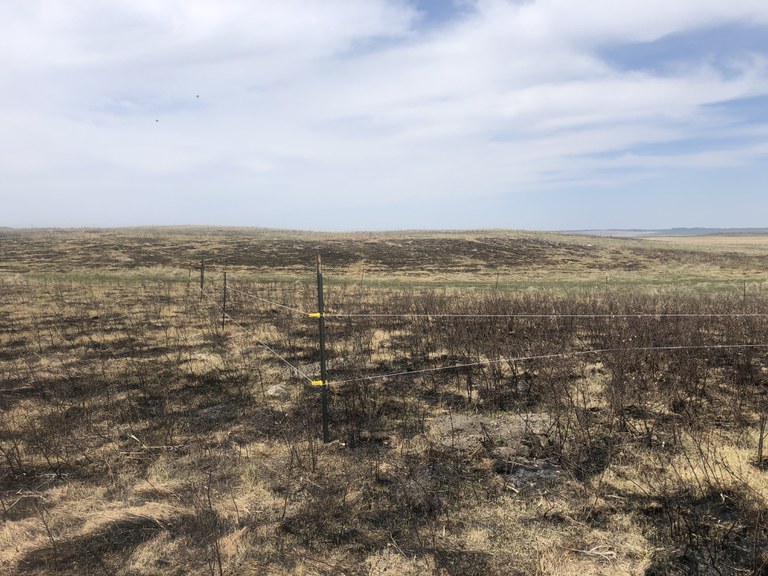
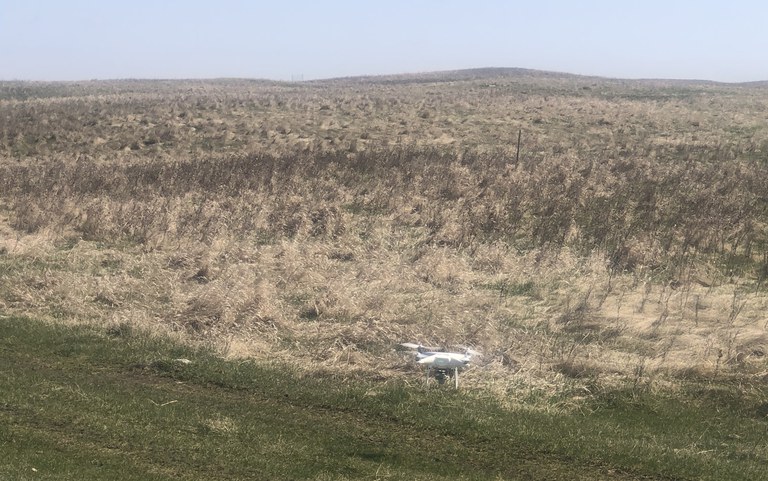
4) Assess mineral (macro and trace) composition of vegetation and soils found in the Missouri Coteau region throughout the grazing season. The intent is to see if our grazing lands lack critical minerals needed for lactating cows.
5) Assess plant composition of rangeland forage consumed by lactating cows throughout the grazing season by identifying DNA markers of plant species from manure samples. The goal is to see if cows eat a different diet when managed using patch-burn grazing, rotational grazing, and season-long grazing.
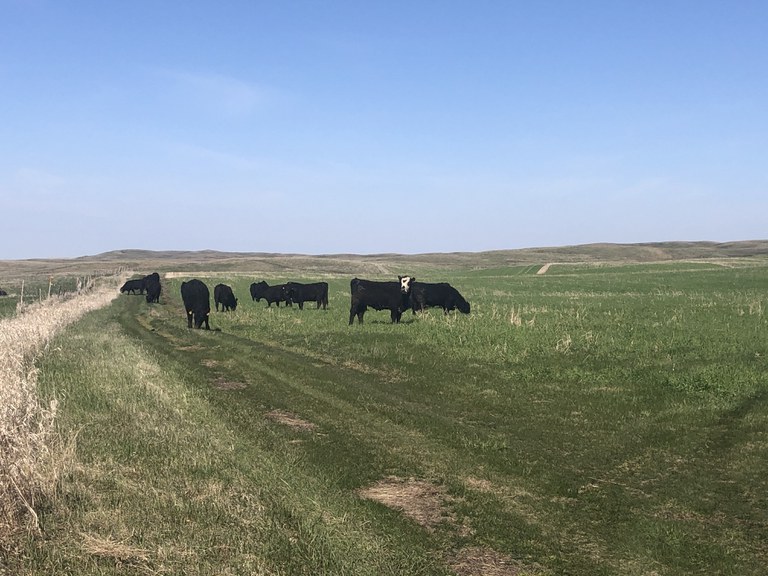
6) Test different cow grazing monitoring techniques that can map grazing patterns by treatment. We will compare GPS collars developed by Dr. McGranahan (we have used these for three years) with precision agriculture solar-driven GPS ear tags.
7) Follow the impacts of minerals (mineral versus no mineral) fed in the diet of growing, to-be first calf heifers on reproductive performance and reproductive performance of their daughters (fetal programming study). We started a similar trial in 2019 testing energy diets.
8) Assess impacts of different grazing treatments on rangeland and seeded cover crops on microbial diversity and richness, carbon sequestration, and methane-consuming bacteria.
9) Comparison of forage production and quality of selected varieties of forage barley, forage oats, grain oats, spring triticale, and forage wheat (new). This study will be located at the center and Wishek (thanks to the Carrington REC agronomy team).
Finally, the CGREC has a new NDAWN station that was completed in May. This station will have the most current technology that allows for us to measure snow, soil depths to 80 inches, and imagery, with plans for it to go live by September. Thanks to Daryl Richardson and his staff for completing the new station.
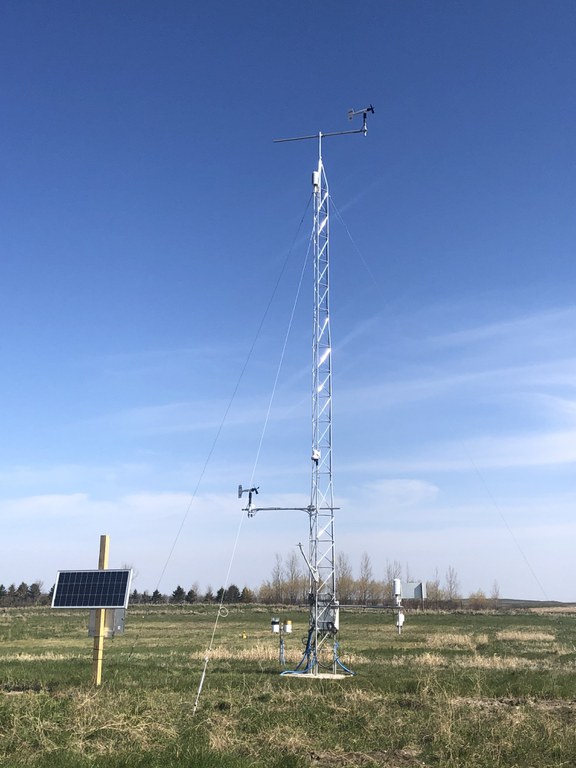
Although we will be dealing with the consequences of Covid-19 this summer, it should be an exciting year for research and Extension programming. The center can’t do all these projects without collaboration with the Main Station scientists, partner RECs and industry. We partner with the School of Natural Resource Sciences (Range, Soils, Entomology), Animal Sciences, Plant Sciences, Microbiology, and Agricultural and Biosystems Engineering; Carrington, Hettinger and North Central RECs; and the USDA-ARS near Mandan. Graduate students are critical in conducting research that addresses numerous questions and cutting-edge science.
Let me end by providing an invitation to the 2020 CGREC field day July 28. We will hold two tours, a forage and livestock tour from 10:00 am to noon, and a tour showing the pollinator/bird and grazing management projects from 1:00 to 3:00 pm. This year’s tour may be conducted with some modifications due to Covid-19.
Whenever you get the chance, enjoy the outdoors and the pleasures it provides. From the beauty of our grasslands, to the songs and sightings of the many birds and wildlife species, and the joys of watching a cow with her calf enjoying the bounty our grasslands provide; know that our natural resources provide you with food, water, shelter, energy, clean air, and recreation. Have a great summer and enjoy a walk through the pasture.
Photos by Kevin Sedivec, NDSU
County Corner: Spring Planting Recommendations
Alicia Harstad, NDSU Extension Agent, Stutsman County
Below are some planting recommendations for wheat, corn and soybeans.
Wheat
Wheat is a cool-season grass and germinates at a soil temperature of 35°F. The optimal planting timing for wheat if you are between Interstate 94 and North Dakota Highway 13 is the third week of April, and if you are between I-94 and U.S. Highway 2, the optimal planting timing is the fourth week of April.
The last recommended planting date if you are between I-94 and Highway 13 is the third week of May, and if you are between I-94 and Highway 2, the last planting date is the fourth week of May.
Planting wheat after June 1 is not recommended unless it will be used for grazing. The estimated yield loss for planting wheat past the optimal plant date is 1% per day. However, this is not always the case because weather is never the same year to year.
Wheat reaches the highest yield potential when it develops under cooler temperatures, especially during the vegetative and early reproductive stages. Seeding rates should be increased by 1% for each day planting is delayed up to a maximum of 1.6 million seeds per acre. The desired plant population for spring wheat is 1.3 million to 1.4 million plants per acre.

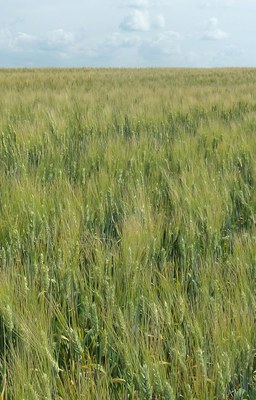
Corn
The recommended planting time for corn is the first two weeks of May. Corn is a warm-season grass and germinates at a soil temperature of 50°F. It also needs 110 growing degree-days (GDDs) before it emerges from the soil (use soil temperature in calculating GDDs rather than air temperature).
Corn that takes longer to emerge in cold soils has a greater risk of seedling diseases and variability in emergence that can result in an uneven stand. Late-emerged corn plants have a yield penalty because they never are able to catch up to the earlier emerged corn plants.
If possible, avoid planting right before a cold rain event to help prevent uneven corn emergence. Fortunately, the soil does warm quickly this time of year with sunny conditions. As you get toward the end of May, consider switching to an earlier maturating variety.
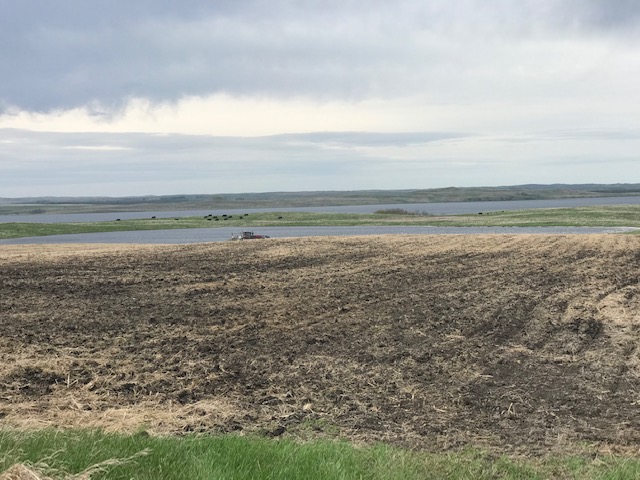
Soybeans
Soybeans are a warm-season broadleaf that germinates when soil temperature reaches 54°F. Experts recommend you start planting soybeans as soon as the soil temperatures are consistently at 50°F and air temperatures are favorable. In some years, this can be as early as the first half of May.
Earlier seeded soybeans have advantages because they allow the use of full-season varieties and quicker canopy closure. However, soybeans are susceptible to cold air temperatures and cold soils; thus, planting too early can result in reduced seed germination, increased risk of seedling diseases and stand reductions. Earlier-maturing varieties can be planted as late as early June.
A couple of other things to keep in mind as the spring progresses is that you might have to change your planting plan, whether that is switching to an earlier maturating variety or maybe to another crop. If this happens, be sure to have good communication with your seed retailer so that person can help you.
Also, keep in touch with your crop insurance agent about planting decisions if planting does become late. If you end up in a situation where you are deciding between planting late or prevented planting, NDSU Extension has a spreadsheet analyzer to compare the economics of the two options. The prevented planting analysis tool can be found at www.ag.ndsu.edu/farmmanagement/prevented-planting.
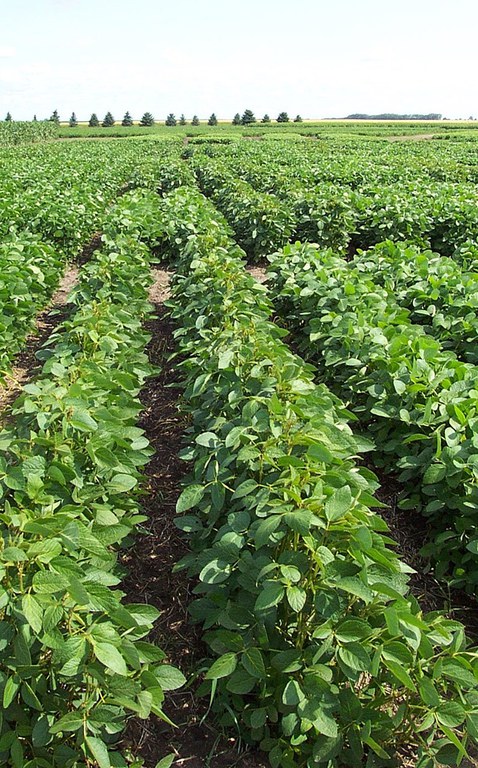
For more information, contact me at NDSU Extension’s Stutsman County office at 701-252-9030 or alicia.harstad@ndsu.edu.
Photos, NDSU
Alternative Protein Sources for the Cow Herd
Karl Hoppe, NDSU Extension Livestock Specialist, Carrington Research Extension Center
Distillers grains have become the favored choice for providing supplemental protein for cattle rations.
Distillers grains, a low-cost protein source that was readily available from local ethanol plants, is sold as dried, modified (50% water) or wet (60% water). The fermented smell, high protein (30% crude protein) content and energy content similar to corn grain make it extremely palatable to cattle. The price of distillers grains was about 110% the value of corn per ton.
Recently, the price of distillers grains has increased dramatically due to reduced production at ethanol plants. This reduction has led cattle producers to seek alternative protein sources.
When looking at protein alternatives, freight to haul the feed to the farm or ranch needs to be considered. While trucking costs vary with distance and backhaul opportunities, freight cost can make on-farm raised proteins competitively priced.
Alfalfa hay continues to be a decent source of protein for cow herds. Feeding 10 pounds of alfalfa hay per cow daily can provide most of the cow’s protein needs. Consistency becomes a problem with alfalfa because protein content and quality are affected by maturity at cutting, rainfall on the windrow prior to baling, leaf loss, moisture content at baling and other factors.
Alfalfa can range from 12% to 22% crude protein (CP), depending on harvest timing and conditions. Field peas are high in protein content (25% to 27% CP) and have similar energy content as corn.
During the past decade, field peas were priced for human food and were not competitively priced for livestock feed unless they were “off spec.” However, with the price of distillers grains increasing to $200 per ton dry and field pea prices lowering to $5.50 per 60-pound bushel, field peas become a lower-priced protein source.
Field peas as a protein source are unique because they are also high in starch. Field peas can be used as a replacement for corn in backgrounding or finishing diets. NDSU research has found meat quality is enhanced with field peas in the ration. However, the cost per pound of energy is usually lowest with corn grain.
Many coproduct feeds are produced in North Dakota. Most coproduct feeds have the starch or oil removed, resulting in a higher protein feed.
One of those coproducts is wheat midds, which are produced by four plants in North Dakota, including the North Dakota Mill and Elevator in Grand Forks, and are 16% to 18% crude protein. Barley malt sprouts no longer are produced in North Dakota because the malting plant at Spiritwood, N.D., ceased operations.
Three oilseed processing facilities in North Dakota crush canola, sunflowers, soybeans and flax. These are all high-protein meals that are greater than 34% crude protein. These plants are flexible in what they crush for the month, so supplies of each oilseed meal may vary.
Usually soybean meal is the most expensive oilseed meal per pound of protein. However, with the recent drastic increase in distillers grains price, soybean meal now is a lower-priced protein source (per pound of protein).
While all protein prices are interconnected in pricing, markets and prices change. These changes indicate other protein sources are more cost competitive.

ADM Velva – 800-548-8613
ADM Enderlin – 701-551-2868
Cargill, West Fargo – 701-282-1626
Photos, NDSU
Needle Cast Disease in Spruce Trees
Alicia Harstad, NDSU Extension Agent, Stutsman County
I have received several calls asking about what is wrong with older spruce trees. One of the most common spruce tree diseases here is needle cast.
The classic symptoms of needle cast include brownish- purple discoloration and eventual death of older needles, while current-year needles show no symptoms. A key characteristic of needle cast is rows of very small black dots (fungal fruiting bodies) that displace the normally white stomata along the length of the underside of needles.

- Spruce tree severely infected with needle cast
Photo from: www.ag.ndsu.edu/cpr/forestry/needle-cast-diseases-of-spruce-diagnosis-and-treatment
Two needle cast diseases occur in North Dakota: Rhizosphaera needle cast and Stigmina needle cast.
Rhizosphaera needle cast primarily infects Colorado blue spruce, while Stigmina needle cast affects Colorado blue spruce and Black Hills spruce. A lab test is the only way to determine the difference between the two needle cast diseases.
Proper diagnosis of needle cast is recommended before treatment is initiated because nondisease factors can cause similar symptoms. Other pests and environmental problems can cause browning and death of older needles, including normal needle death that occurs simply as a function of needle age or shading. The fungal fruiting bodies in the stomata should be identified before treating a tree with fungicide.
Needle cast disease is treatable. Within a few years after treatment, an infested spruce tree can start to produce healthy, new needle growth again. Left untreated, a severe case of needle cast can lead to continual thinning and decline of the tree.
Needle cast diseases can be controlled effectively with fungicides containing chlorothalonil (Bravo is an example of one tradename). Fungicide should be applied to the whole tree to prevent the disease from spreading to the new needle growth.
Treatment for needle cast is two properly timed applications of chlorothalonil per year. The first application should occur when the new needles are half elongated (50% elongation relative to previous years’ needle length). A general rule of thumb typically is to apply the first treatment around Memorial Day. The second application should occur two to three weeks after the first application.
NDSU Extension has two publications with more information about needle cast: “Diagnosing Spruce Disorders in North Dakota” (F1818) and “Two Needle Diseases of Spruce in North Dakota” (F1680). They can be found online or by contacting the Extension office.
For more information about needle cast or other questions, please contact NDSU Extension’s Stutsman County office at 701-252-9030 or e-mail me at alicia.harstad@ndsu.edu.
Utilizing Cover Crops to Extend Grazing: A Focus on Economics and Soil Health
Erin M. Gaugler, Range Research Specialist, Central Grasslands Research Extension Center
Producers are often challenged by the cost of production and other economic uncertainties.
The U.S. Department of Agriculture reported that the highest cost experienced by livestock producers was purchased feed. Strategies can be implemented to reduce the cost of production, although it is unlikely to alter market prices.
Research has demonstrated that an extended grazing season has the ability to reduce feed costs, thereby lowering production costs. Information regarding monoculture crops has been readily available, but the exploration of mixed species in a cropping system has been somewhat limited.

Studies suggest that a major advantage of forage mixtures is the ability to accumulate dry matter late into the growing season, which allows for an extended grazing period. The selection of an appropriate cocktail mixture also can result in an increase of forage and nitrogen yield while serving as a cover crop.
The perceived benefits of cover crops are closely tied with soil health. Research suggests that cover crops reduce sediment transport, increase nutrient use efficiencies and limit nitrate-nitrogen leaching. The development of cropping systems that conserve soil and water quality are a crucial aspect of maintaining forage production and quality.
As producers continue to be challenged by the elevated costs of production, a need persists to evaluate the economics of using annual forages to extend the grazing season. A study performed at the Central Grasslands REC during 2012-2014 evaluated the effects of an annual forage cover crop (multi species) on herbage production, livestock performance, economic efficiency and soil health as affected by three grazing strategies.
The use of the annual forage cover crop was evaluated in single- and dual-crop production systems. The cropping systems were subjected to the following grazing treatments: 1) full use, 2) 50% degree of disappearance and 3) no use.
A no-till drill was used to establish cropping systems. The annual cash crop was planted in mid-May, the single crop (annual cover crop) was planted in mid-July, and the dual crop (cash crop followed by annual cover crop) was planted in late July or early August during all years of the study.
The cover crop mix consisted of: forage oats - 15 pounds per acre (lb/ac), field peas - 10 lb/ac, sorghum sudangrass - 4 lb/ac, sunflowers - 1.5 lb/ac, forage radish - 1 lb/ac and pasja turnip - 0.5 lb/ac. In 2014, sorghum sudangrass was unavailable, so it was replaced with foxtail millet seeded at a rate of 4.5 lb/ac.

Mid-gestation, Angus crossbred beef heifers were assigned to grazing treatments from mid-October to late November or early December. Electric poly-wire fence and step-in posts were utilized as portable cross fences within each plot to increase grazing efficiency.

Average annual precipitation (April-September) was 14.5 inches, which equates to nearly 2.4 inches of rain per month. Variability of mean seasonal precipitation was minor in relation to the 30-year average, with the exception of June, July and August of 2013 (Figure 1; NDAWN, 2020).
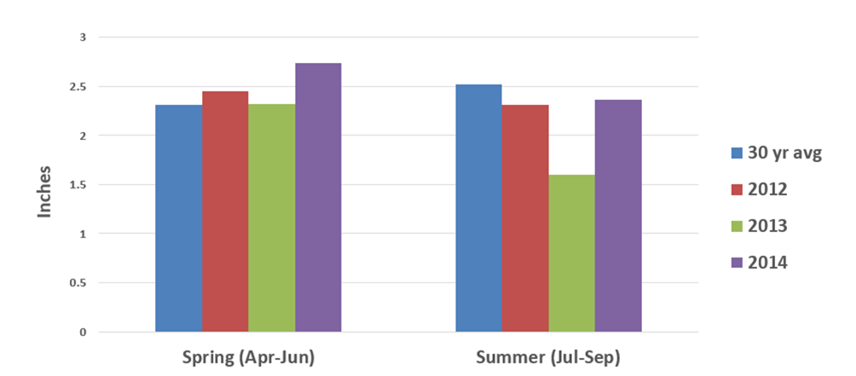
Figure 1. Average monthly precipitation levels1 (inches) by month and year at Central Grasslands Research Extension Center near Streeter, N.D., during 2012 to 2014 growing seasons. 1Data obtained from NDWN, 2020.
Herbage production in the single and dual crop was variable across all treatments (Figure 2). However, production was different between cropping systems, with the single crop producing greater amounts of forage during all three years. The production of the annual cover crop in the dual-crop system during 2013 was significantly reduced, which is likely due to limited moisture conditions during July and August.
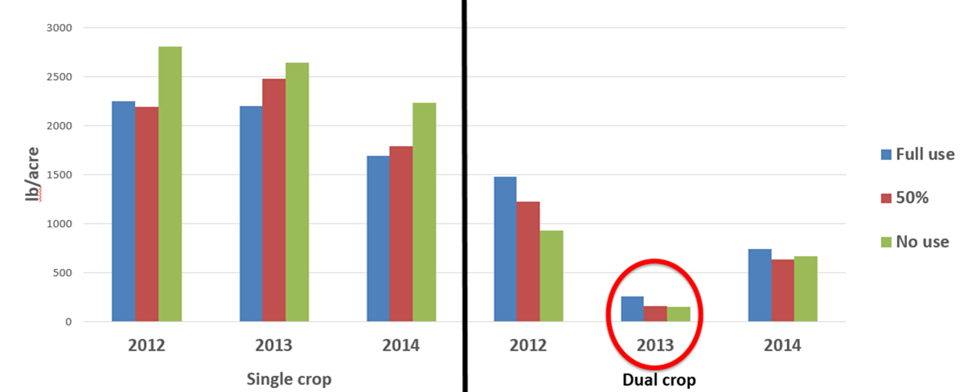
Figure 2. Average production (lb/ac) of single-crop and dual-crop systems by grazing treatment and year at Central Grasslands Research Extension Center near Streeter, N.D., during 2012 to 2014.
The average daily gain of livestock was monitored in grazing treatments and compared with performance in a dry-lot setting (Figure 3). During 2012 and 2014, we observed a significant difference between full-use grazing treatments and the dry lot.
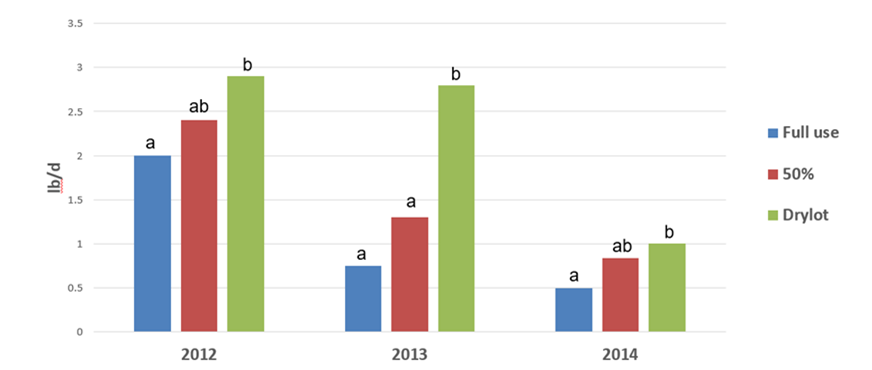
Figure 3. Average daily gain (lb/day) of beef heifers by treatment and year at Central Grasslands Research Extension Center near Streeter, N.D., during 2012 to 2014.
In 2013, we observed significant difference between both grazing treatments and the dry lot. The gains achieved in the dry lot suggest that a more involved control of feed rations might account for differences, when compared with grazing systems. Differences in forage quality and energy expenditure, which were not accounted for during the study, could have influenced the performance of livestock.
Grazing costs were monitored by treatment and compared with a dry lot (Table 1). Land was valued according to the average rental rates of non-irrigated cropland for Kidder County (National Agricultural Statistics Service [NASS], 2012; North Dakota Trust Lands, 2013; North Dakota Trust Lands, 2014).
North Dakota custom rate values were used for seeding, combining and herbicide application (NASS, 2010; NDSU, 2013). Actual costs were used for seed, fertilizer and herbicide.
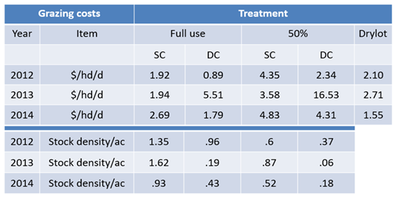
Table 1. Grazing costs ($/head/day) and stock density (pounds/acre) of single-crop (SC) and dual-crop (DC) systems by grazing treatment at Central Grasslands Research Extension Center near Streeter, N.D., during 2012 to 2014.
Grazing costs in 2013 were relatively higher than grazing treatments during 2012 or 2014. The departure from normal precipitation likely resulted in limited herbage production, which reduced stocking rates and increased the cost per head per day. When moisture and herbage production was adequate, and when commodity prices were strong, the full-use grazing treatment of annual cover crops appeared to have the potential to be cost effective.
Aggregate stability, which refers to the ability of soil aggregates to resist disruption when outside forces are applied, also was monitored (Table 2). A year effect occurred in the grazed treatments and showed an increase in aggregate stability.
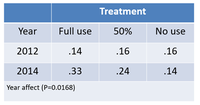
Table 2. Aggregate stability (whole soil stability index) measured by grazing treatment and year during 2012 to 2014.

Bulk density was collected at two different depths to monitor the soil’s ability to function for structural support, water and solute movement, and soil aeration (Figure 4). Any practice that improves soil structure (aggregate stability) generally will decrease bulk density. While we found no statistical differences, a trend of decreasing bulk density occurred at both depths.
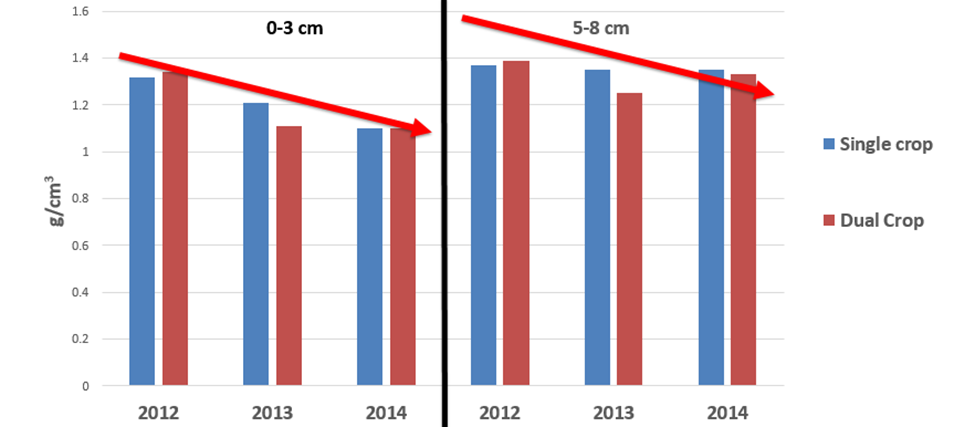
Figure 4. Bulk density (grams/centimeters3) of single-crop and dual-crop systems by grazing treatment, depth and year at Central Grasslands Research Extension Center near Streeter, N.D., during 2012 to 2014.
The full-use grazing treatment positively contributed to physical characteristics of soil health. Additionally, when used as a part of the dual cropping system, the treatment demonstrated potential to be cost effective in years when moisture was available. However, limited precipitation negatively affected forage production and economics.
The 50% utilization rate never was cost effective in either cropping system. Livestock performance was positive across all treatments, although rates were variable. When selecting feeding strategies, what is important is to consider the goals of an operation that includes the future use of animals and their expected performance.
To learn more about this study or to hear about other range research projects at the Research Extension Center, feel free to contact me at 701-424-3606.

Photos by Erin Gaugler, NDSU
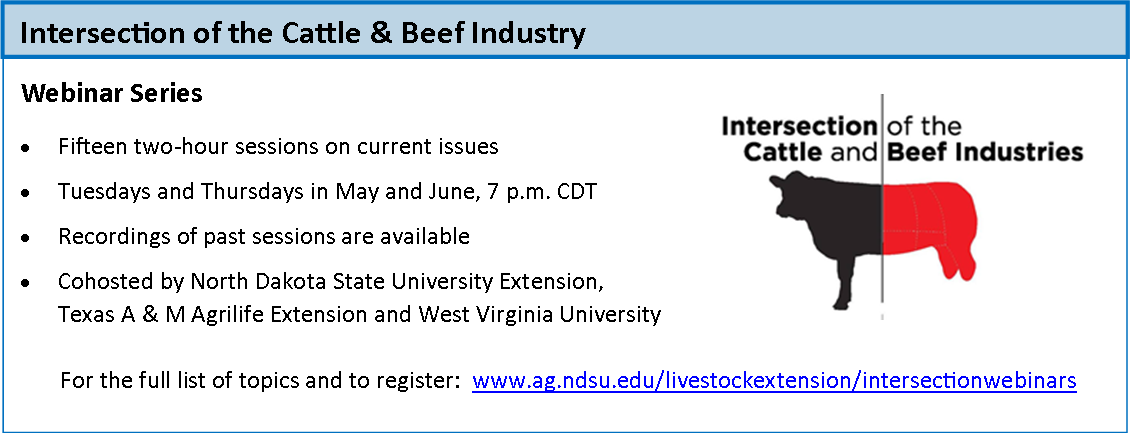
Upcoming Events
(subject to change due to Covid-19)
July 28: CGREC Advisory Board Meeting
July 28: CGREC Annual Field Day
Aug 4—7: Range Youth Camp, Amidon, N.D.
Contact: sandi.dewald@ndsu.edu
 Photo by Erin Gaugler, NDSU
Photo by Erin Gaugler, NDSU
Central Grasslands Forum - Spring 2020



